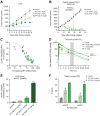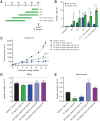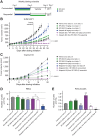RP-3500: A Novel, Potent, and Selective ATR Inhibitor that is Effective in Preclinical Models as a Monotherapy and in Combination with PARP Inhibitors
- PMID: 34911817
- PMCID: PMC9398170
- DOI: 10.1158/1535-7163.MCT-21-0615
RP-3500: A Novel, Potent, and Selective ATR Inhibitor that is Effective in Preclinical Models as a Monotherapy and in Combination with PARP Inhibitors
Abstract
Ataxia telangiectasia and Rad3-related (ATR) kinase protects genome integrity during DNA replication. RP-3500 is a novel, orally bioavailable clinical-stage ATR kinase inhibitor (NCT04497116). RP-3500 is highly potent with IC50 values of 1.0 and 0.33 nmol/L in biochemical and cell-based assays, respectively. RP-3500 is highly selective for ATR with 30-fold selectivity over mammalian target of rapamycin (mTOR) and more than 2,000-fold selectivity over ataxia telangiectasia mutated (ATM), DNA-dependent protein kinase (DNA-PK), and phosphatidylinositol 3-kinase alpha (PI3Kα) kinases. In vivo, RP-3500 treatment results in potent single-agent efficacy and/or tumor regression in multiple xenograft models at minimum effective doses (MED) of 5 to 7 mg/kg once daily. Pharmacodynamic assessments validate target engagement, with dose-proportional tumor inhibition of phosphorylated checkpoint kinase 1 (pCHK1) (IC80 = 18.6 nmol/L) and induction of phosphorylated H2A.X variant histone (γH2AX), phosphorylated DNA-PK catalytic subunit (pDNA-PKcs), and phosphorylated KRAB-associated protein 1 (pKAP1). RP-3500 exposure at MED indicates that circulating free plasma levels above the in vivo tumor IC80 for 10 to 12 hours are sufficient for efficacy on a continuous schedule. However, short-duration intermittent (weekly 3 days on/4 days off) dosing schedules as monotherapy or given concomitantly with reduced doses of olaparib or niraparib, maximize tumor growth inhibition while minimizing the impact on red blood cell depletion, emphasizing the reversible nature of erythroid toxicity with RP-3500 and demonstrating superior efficacy compared with sequential treatment. These results provide a strong preclinical rationale to support ongoing clinical investigation of the novel ATR inhibitor, RP-3500, on an intermittent schedule as a monotherapy and in combination with PARP inhibitors as a potential means of maximizing clinical benefit.
©2021 The Authors; Published by the American Association for Cancer Research.
Figures






Comment on
-
Selected Articles from This Issue.Mol Cancer Ther. 2022 Feb;21(2):243. doi: 10.1158/1535-7163.MCT-21-2-HI. Mol Cancer Ther. 2022. PMID: 35135870 No abstract available.
References
-
- Blackford AN, Jackson SP. ATM, ATR, and DNA-PK: The trinity at the heart of the DNA damage response. Mol Cell 2017;66:801–17. - PubMed
-
- Lecona E, Fernandez-Capetillo O. Targeting ATR in cancer. Nat Rev Cancer 2018;18:586–95. - PubMed
-
- Toledo LI, Altmeyer M, Rask MB, Lukas C, Larsen DH, Povlsen LK, et al. . ATR prohibits replication catastrophe by preventing global exhaustion of RPA. Cell 2013;155:1088–103. - PubMed
-
- Foote KM, Nissink JWM, McGuire T, Turner P, Guichard S, Yates JWT, et al. . Discovery and characterization of AZD6738, a potent inhibitor of ataxia telangiectasia mutated and Rad3 related (ATR) kinase with application as an anticancer agent. J Med Chem 2018;61:9889–907. - PubMed
Publication types
MeSH terms
Substances
LinkOut - more resources
Full Text Sources
Other Literature Sources
Medical
Molecular Biology Databases
Research Materials
Miscellaneous

